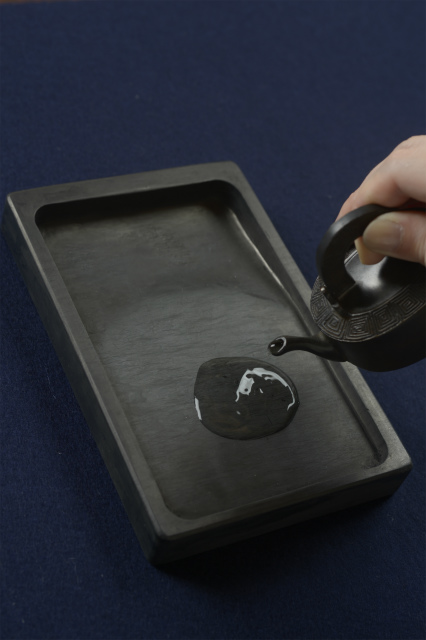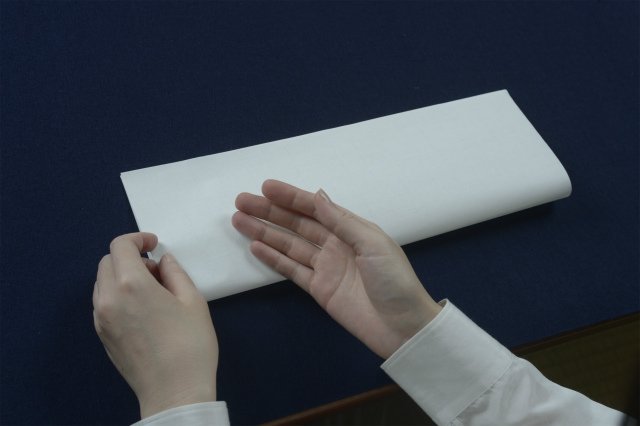書道事始
At the start of calligraphy
大人になり、改めて書道に興味を持ったものの、どこから始めればいいのか分からない、
また書の作品はどのように鑑賞すればいいのか分からない、という声をよく聞きます。
そこで「目習い」「手習い」という2つのアプローチを取り入れた、
書道の基本的な心得をここに公開。
I often hear people say like this: when I have a renewed interest in calligraphy as an adult, I have no idea as to where I should begin from or how to appreciate a piece of calligraphy works. To answer these questions, I would like to show here a few fundamental points of learning calligraphy, including dual approaches of seeing and manual ways of learning.
事前に用意するもの
Materials prepared beforehand
①紙 ②文鎮 ③下敷 ④筆立て ⑤筆 ⑥水滴 ⑦墨池
⑧硯 ⑨印泥(いんでい)⑩印矩(いんく)⑪印 ⑫墨床 ⑬墨
上記、用具のなかでも特に、「筆・墨・硯・紙」を「文房四宝(ぶんぼうしほう)」と言います。
1 paper 2 paper weight 3 under pad 4 brush stand 5 brush 6 water pot 7 an ink pot 8 inkstone 9 seal paste 10 L-shaped guide for sealing 11 seal 12 inkstick rest 13 sumi ink
Among materials above-mentioned, brush, sumi inkstick, inkstone, and paper are called four treasures of the study.
筆
Brush
「筆」は、柔らかい山羊の毛、やや堅い馬、鼬(いたち)の毛などで作られており、基本的には好みになりますが、初心者の方にはこれらが程良くブレンドされた兼毛(けんもう)の筆が書き易く、お勧めです。また、筆の軸の部分の太さには号数があり、一般的には3~4号ですが、実際に手にとって持ち味を確かめてみましょう。
Brushes are made of soft goat hair, a little rigid horse hair, weasel hair and so on. Which one is better depends on your liking, but for beginners I recommend one made of a mixture of various hairs which is easy to use. In addition, brushes are classified according to the thickness of the brush stick. Generally speaking, the thickness No.3 and No.4 are suitable, but I recommend you to try to examine with your own hand to see which one is fitting.
墨&硯
Sumi ink & inkstone
「墨」は、形状としては固形墨と液体墨(墨液、墨汁とも呼ばれます)があります。固形墨はワインと同じで、製造されてから長い年月を経ているものの方が良く、豊かな線質が表現できる墨となります。ただ、一度にたくさん書きたいという方は、液体墨でも質の良いものが市販されていますので、それを使用するのも良いでしょう。
「硯(すずり)」は墨の粒子が細かく均一になるものが良い硯とされて、金額も高くなります。液体墨を使う時は、墨を磨る必要がないので、墨池(ぼくち)という容器に墨を入れます。これは硯の表面にある「目」によって筆を痛めることもなく、また、多量の墨を使用でき、簡単に洗い流せるので便利です。
Sumi ink is available either in a solid or liquid form. Liquid ink is also called bokuju
or bokueki. Solid form of ink is considered better for its longer lapse of time since its production just as the case of wine, because it allows us to express richer quality of lines. However, those who would like to practice a lot at one time could use liquid form of ink, for good quality of liquid ink is available at stores.
As for inkstone, good one is for sumi inkstick to be made fine and even when ground, but rather expensive. When using liquid ink, it is stored an ink pod called “bokuchi”, there being no need of grinding inkstick. Liquid ink is very convenient, because rough surface of an inkstone doesn’t give damage to the brush, a lot of ink can be used, and it is easy to wash away with water.
紙
Paper
「紙」は紙質によって、線の性質(書き味)や墨の色あい(滲みや掠れ)の違いが出ますので、紙選びは重要です。また、紙の繊維のザラつきを活かして書くと線に強さが出たりします。どのような作品を書きたいのかをお店の人に伝え、相談してみましょう。ただ、練習用の半紙なら、1000枚入りの安くて書き易いものでかまいません。
What kind of paper you choose is very important. Because the quality of paper has much to do with quality of lines (smoothness of brushstroke)or colors of sumiink(bleeding and blurs). You had better consult a staff of the store telling him or her what kind of calligraphy works you would like to produce. But in the case of stuff for practice, an inexpensive package of paper of 1000 pieces will do, as long as they are easy to use.
☞2023年1月 新規講座のご案内はこちらをクリックください



